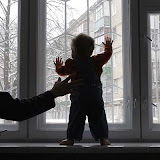It’s not hard to learn the current radiation levels across Fukushima Prefecture. You can hear them on the evening news, along with the weather, or read yesterday’s totals in the local paper. Outside many public buildings there are dosimeters showing current readings. (1)
What is harder to grasp is the
meaning of all these numbers. In the past two years, the Japanese public has
had a (new) crash course in radiation. The first question for many was Am I safe here?—can I breathe, eat, fish,
swim, plant a garden, let my kids play outside? Unfortunately, there are
only two honest answers to such questions: (1) Maybe, and (2) We don’t know.
Acute Radiation Sickness (caused
by a high exposure in a short period) has a well-defined set of symptoms. However,
for low-level exposure to radiation over a long period, it remains impossible
to predict how any individual will be affected. Will some radioactive particle
you ingested trigger cancer or not? It is all a question of probabilities, and
there are too many variables and too little research to know.
One school of thought, the linear
no-threshold (LNT) model, argues that there is no safe level of exposure—your risk
is directly proportional to your dose. A competing view, the threshold model often
used in toxicology, argues that minute exposures to radiation are harmless. In
this view, the important question is determining what the safe threshold is. A
third perspective, the radiation hormesis model, argues that radiation at very
small doses is actually beneficial because it triggers cellular repairs.
In Fukushima, with no conclusive
data available, residents are stuck deciding if the risk from radiation, in
their personal assessment, is large enough to outweigh the definite costs of
moving, such as loss of home, community and employment. Just as in Chernobyl, people
under 35 are more likely to leave and say they will not return (2). Once you
decide it’s not safe here, the next question is: where is safe?
Sources:
(1)
Fukushima City website, Environmental Division. English translation.
(2)
According to a survey in Futuba by Fukushima University, reported in Yomiuri
Shimbun.
(3) Rocket News 24.Tomorrow: Chernobyl quiz winners.




